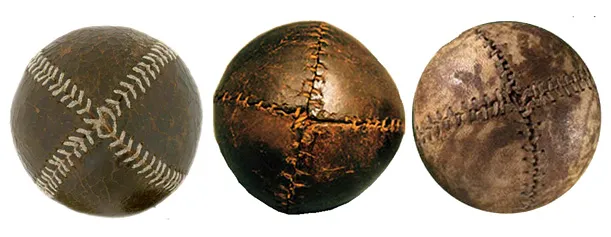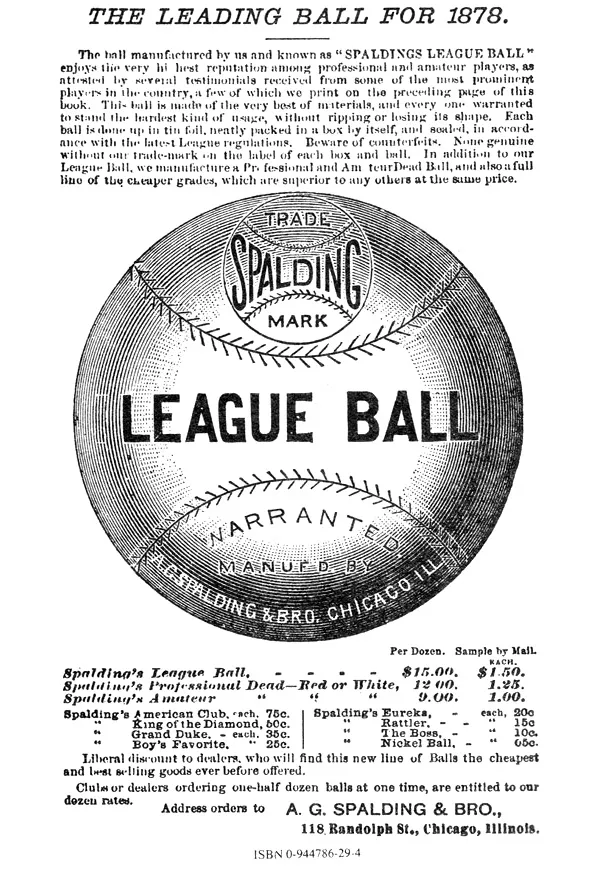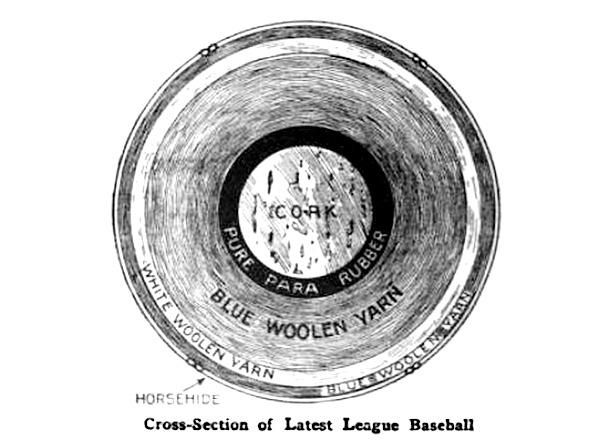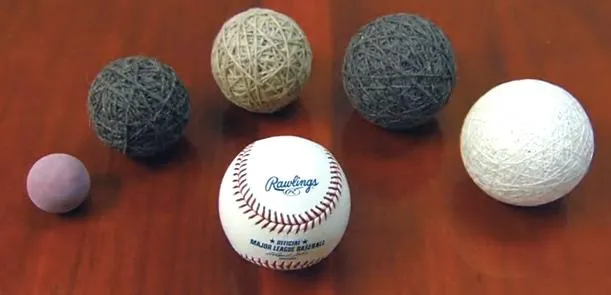A Brief History of the Baseball
The development of the baseball, from shoe rubber and lemon peels to today’s minimalist, modernist object
/https://tf-cmsv2-smithsonianmag-media.s3.amazonaws.com/filer/20130628103037baseball-thumb.jpg)
From the fields and stadiums, to the uniforms, to the statistics, baseball is good design. There’s no better evidence of that than the iconic white and red ball. With its pristine white surface and high contrast red stitching, today’s baseball is a beautiful union of form and function, an almost ideal Modernist object. But it didn’t start out that way. The baseball didn’t emerge fully formed when the first batter stepped up to the first plate. Like the football, it’s hard to attribute its invention to one person, especially considering that in those heady, mustachioed, pre-professional days of baseball, balls were made by cobblers from the rubber remnants of old shoes, with rubber cores wrapped in yarn and a leather cover – if you were lucky. In some regions, sturgeon eyes were used instead of melted shoe rubber. In the 1840s and ’50s, it was anything but an exact science and pitchers often just made their own balls. Obviously, there was some variety in size and weight that resulted just from the nature of the handmade process and separate regional developments.

The differences extended from the center of the core to the surface of the leather wrapping. One of the more prominent cover designs wrapped the wound core in a single piece of leather tied off with four distinct lines of stitching, earning it the apt nickname “lemon peel.” These balls were smaller –about six inches in circumference compared to today’s nine- and they were lighter (in weight), darker (in color) and softer (in softness) than those used today. And the game was a little different too. In the earliest games, runners could be thrown out by getting “soaked,” or hit directly with a ball by a fielder – a rule still occasionally practiced on playgrounds and sandlots. These light, compact balls with rubber (or fish-eye) cores were much “livelier” than today’s balls – that is to say, the could be hit further and bounce higher. The result was a scoreboard that looked like something from a basketball game.
In the mid 1850s, ball clubs in the New York area elected to standardize the ball’s weight at 5.5-6 ounces and its circumference at somewhere between 8 and 11 inches, resulting in a larger, heavier, less lively ball. There was obviously some room for variety, but it was the first step toward regulation.
Throughout the 1850s and ’60s, the ball (and the rules) continued to evolve but there was still plenty of room for variation – more rubber in the core and a tighter winding resulted in a “live” ball while less rubber and a loose wind yielded a “dead” ball. Of course, home teams made the balls best suited to their own strengths and style of play. Ball selection was a key strategy and a critical benefit of home-field advantage. Visiting teams with big hitters would, more often than not, find themselves playing with a “dead” ball.
There is some debate about the origin of the 2-part “figure 8” cover that we we know today. Some baseball historians say it was first developed by a shoemaker’s son named Ellis Drake, who supposedly put the design together with some of his father’s scrap leather in an effort to create a more resilient cover. If this is true, Drake failed to patent his idea and others started producing similar designs. Others give credit to Colonel William A. Cutler, who may have invented the familiar stitching in 1858 and sold it to one of the first baseball manufacturers, William Harwood. Regardless of who created it, the figure 8 became the dominant ball thanks to Harwood & Sons, who built the first factory dedicated to baseball production in Natick, Massachusetts, and was the first to mass-produce the figure 8 design.
In the 1870s, the fluctuating size and weight of the fluctuating was stabilized to something very similar to the one we know and love today, which is officially,and rather vaguely, mandated by the MLB by rule 1.09:
The ball shall be a sphere formed by yarn wound around a small core of cork, rubber or similar material, covered with two strips of white horsehide or cowhide, tightly stitched together. It shall weigh not less than five nor more than 5.25 ounces avoirdupois and measure not less than nine nor more than 9.25 inches in circumference.

The year 1876 welcomed the first game in the National League of Professional Baseball Clubs and a standardization of rules and regulations – including a standard ball. That same year a Boston Red Sox pitcher by the name of A.G. Spalding retired after winning 241 of 301 games in just a four-year career. He pitched every game with balls he made himself. When he convinced the National League to adopt his ball as its standard, an empire was born. Spalding’s company would continue to produce the official baseball of the National League for 100 years.
Early professional baseball was marked by incredibly low-scoring games – thanks in large part to the ball. Balls were were soft and became softer during the course of a game and were used until they unraveled, resulting in fewer big hits and lower scores. This was the original “dead-ball” era of baseball.

In 1910 the cork-core ball was introduced into Major League play. As Popular Mechanics explained at the time, “the cork makes possible a more rigid structure and more uniform resiliency. It is said to outlast the rubber center balls many times over, because it will not soften or break in spots under the most severe usage.” More importantly though, it could be hit. With the introduction of the livelier cork ball, league-wide batting averages jumped almost immediately. After a few years, however, pitchers began to adapt (and develop a few tricks) and numbers began to level out – until Babe Ruth started hitting balls out of the park; dead-ball era came to a final, stunning end. Ruth started something and baseball enjoyed a live-ball renaissance that actually had nothing to do with the ball, despite popular conspiracy theories that a new, more lively “rabbit” ball was secretly introduced into play in 1920 to increase hitting.
The next big innovation came in 1925 when Milton B. Reach patented the “cushion cork” center, in which a a sphere of cork is surrounded by a black semi-vulcanized rubber, which is then surrounded by another layer of red rubber. In 1934, the American League, which favored live balls and big hitters, and the National League, known to use thicker, looser balls that favored pitchers, agreed on a standard ball. As noted in a great article on the baseball’s history from Bleacher Report, the composition of this new “medium ball” was revealed for the first time in The New York Times:
Major league baseballs start with a core of cork mixed with a small amount of rubber. This is covered by a layer of black rubber, then by a layer of red rubber. It is then ready for the winding process, where yarn is added to the core. This is done on a revolving machine…in a humidity- and temperature-controlled room.
Yarn windings consist first of 121 yards of rough gray wool, forty-five yards of white wool then 53 yards of fine gray wool and finally 150 yards of fine white cotton. After these layers have been added to the sphere, it is coated with rubber cement. Then two pieces of horsehide in the shape of the figure ’8′ are hand-stitched with red thread to cover the ball.
….Each ball has 108 hand-stitched double stitches in its cover. A finished ball weighs from 5 to 5 1/4 ounces and measures not less than 9, nor more than 9 1/4 inches.
With a few exceptions, the baseball really hasn’t changed that much since then.

Surprisingly, the process hasn’t changed much either. All 108 red stitches on Major League baseballs are all still stitched by hand, although ball consistency has improved with new technology – materials are now stored in temperature controlled facilities and balls are wound under constant tension to eliminate “soft spots” and guarantee a uniform surface. Also similar to years past: every season is different from the last. Some seasons see a lot of home runs while others see pitchers locked in battle. So far this year, teams have scored the fewest runs per game (4.22) since 1992, when it was 4.12. Granted, the hot summer months where the balls soar through the humid air have yet to come, but it looks like the men on the mound have the upper hand.
Sources:
“Evolution of the Ball,” Baseball Digest (July 1963); Peter Morris, A Game of Inches: The Stories Behind The Innovations that Shaped Baseball (Rowman & Littlefield, 2006); Josh Chetwynd, The Secret History of Balls (Penguin, 2011); Zack Hample, The Baseball: Stunts, Scandals, and Secrets Beneath the Stitches (Random House, 2011); Zachary D. Rymer, “The Evoution of the Baseball from the Dead ball Era Through Today,” Bleacher Report (June 18, 2013); 19th Century Baseball
/https://tf-cmsv2-smithsonianmag-media.s3.amazonaws.com/accounts/headshot/Jimmy-Stamp-240.jpg)
/https://tf-cmsv2-smithsonianmag-media.s3.amazonaws.com/accounts/headshot/Jimmy-Stamp-240.jpg)